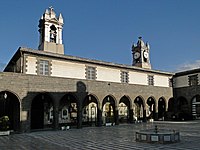Nephonite Church: Difference between revisions
(Created page with "{{Infobox Christian denomination | name = Nephonite Church<br>Holy Church of the Orient | native_name = كنيسة المشرق المقدسة<br>Ιερ...") |
No edit summary |
||
| (2 intermediate revisions by the same user not shown) | |||
| Line 51: | Line 51: | ||
| recognition = | | recognition = | ||
| separated_from = | | separated_from = | ||
| branched_from = [[The | | branched_from = [[The Pylan Church]] | ||
| merger = | | merger = | ||
| absorbed = | | absorbed = | ||
| Line 81: | Line 81: | ||
| footnotes = | | footnotes = | ||
}} | }} | ||
The '''Nephonite Church''', or '''Holy Church of the Orient''', is a {{wp|Autocephaly|autocephalous}} {{wp|Eastern Christianity|Oriental Church}} founded in 379 AD by {{wp|Saint}} [[Nephon the Quarreller]], Declaring his {{wp|Diocese}} independent of the Universial Church after the [[Council of Synoropinax]], when the council condemned [[John of Manoubia]] and adopted {{wp|Dyophysitism}} as church doctrine. The Church expanded its reach in the east with the growth of several imperial powers. Between the 4th and 7th Century the church had established itself throughout modern day [[Sarvatia]], [[Zubaydah]], and going as far east as [[Harjavalta]]. While the liturgical language was {{wp|Greek Language|Argean}}, the church adopted the {{wp|Syriac alphabet|Calidic script}} for use in religious liturgy. Thus making the Nephonite church one of the last remaining extant {{wp|Syriac Christianity|Calidic Churches}}. | |||
Starting in the 15th Century the church experianced a {{wp|Schism}} over the investiture of local Bishops, the role the Cathlicos had in the selection of Bishops, the role of {{wp|Catechesis|catechumen}} in church structure, and {{wp|Syneisaktism}} amongst the clergy. This resulted is a split that led to the formation of several [[Tiberian Church|Eastern Tiberian Churches]] as they broke from the church between 1478 and 1546. persucution and conquest destroyed Nephonite communities in the east, and by the 19th Century the church had been pushed back to its homeland in the [[Anutistus]] region of the [[Agoanatolian Subcontinent]]. | |||
Today, the Nephonite Church mostly exists within [[Zubaydah]], but due to a large diaspora population, there have been many more global diocese established since the 1900's. There are roughly 1.14 Million Nephonites globally with roughly 800,000 living in Zubaydah. The Church is headed by {{wp|Cathlicos}} [[Basil IV]], while the broder Nephonite community is reprasented by [[Shamaoun Howayek]] within the [[Revolutionary Committee of Minor People's and Communities]], the church is part of the Ecumenical Assosiation of Oriental Churches, an organization designed to foster intercommunity diologue and support amongst the Oriental Sophisian community. | |||
Latest revision as of 18:47, 24 September 2023
| Nephonite Church Holy Church of the Orient | |
|---|---|
| كنيسة المشرق المقدسة Ιερός Ναός της Ανατολής | |
 Patriarchal Cathedral of Our Lady of Bracchia | |
| Type | Pylan |
| Classification | Oriental Church |
| Orientation | Calidic Sophisianity |
| Theology | Monophysitism |
| Polity | Episcopal |
| Governance | Mother See of Balouta |
| Catholicos | Basil IV |
| Region | Zubaydah, Nephonite diaspora |
| Language | Argean |
| Liturgy | Ageao-Nephonite Rite |
| Headquarters | Patriarchal Cathedral of Our Lady of Bracchia, Mounchantar Zubaydah |
| Founder | St. Nephon the Quarreller |
| Origin | 379 AD Mounchantar |
| Branched from | The Pylan Church |
| Members | 1,142,971 |
The Nephonite Church, or Holy Church of the Orient, is a autocephalous Oriental Church founded in 379 AD by Saint Nephon the Quarreller, Declaring his Diocese independent of the Universial Church after the Council of Synoropinax, when the council condemned John of Manoubia and adopted Dyophysitism as church doctrine. The Church expanded its reach in the east with the growth of several imperial powers. Between the 4th and 7th Century the church had established itself throughout modern day Sarvatia, Zubaydah, and going as far east as Harjavalta. While the liturgical language was Argean, the church adopted the Calidic script for use in religious liturgy. Thus making the Nephonite church one of the last remaining extant Calidic Churches.
Starting in the 15th Century the church experianced a Schism over the investiture of local Bishops, the role the Cathlicos had in the selection of Bishops, the role of catechumen in church structure, and Syneisaktism amongst the clergy. This resulted is a split that led to the formation of several Eastern Tiberian Churches as they broke from the church between 1478 and 1546. persucution and conquest destroyed Nephonite communities in the east, and by the 19th Century the church had been pushed back to its homeland in the Anutistus region of the Agoanatolian Subcontinent.
Today, the Nephonite Church mostly exists within Zubaydah, but due to a large diaspora population, there have been many more global diocese established since the 1900's. There are roughly 1.14 Million Nephonites globally with roughly 800,000 living in Zubaydah. The Church is headed by Cathlicos Basil IV, while the broder Nephonite community is reprasented by Shamaoun Howayek within the Revolutionary Committee of Minor People's and Communities, the church is part of the Ecumenical Assosiation of Oriental Churches, an organization designed to foster intercommunity diologue and support amongst the Oriental Sophisian community.